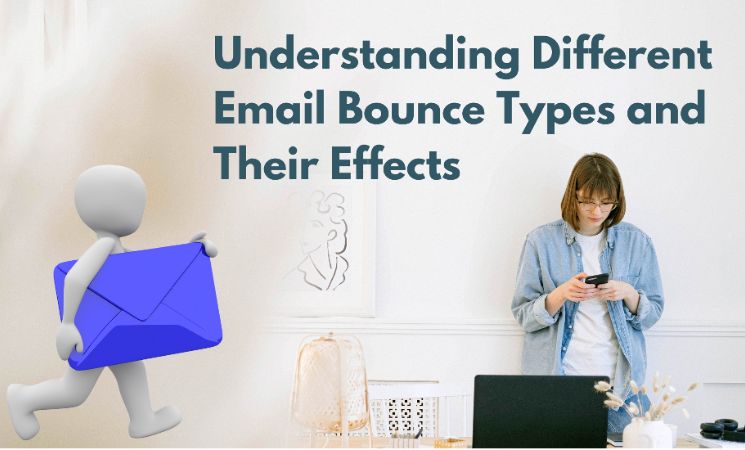Have you ever wondered why some of your emails never make it to your audience’s inbox? Email bounces could be the culprit, but not all are created equal. Some can be resolved quickly, while others might signal bigger issues with your email list.
Knowing the different types of bounces and how they affect your campaigns is crucial to improving deliverability and keeping your emails on track. In this blog, we’ll explore these bounce types and what they mean for your email success. Ready to take control of your inbox performance? Let’s dive in!
Why Email Bounces Matter for Campaign Performance?
Email bounces can do more than just disrupt your campaigns—they can seriously impact your marketing success. Here’s how:
- 1. Harm to Sender Reputation: High bounce rates can damage your reputation with ISPs, increase the chances of reduced deliverability, and result in blacklisting as well. Keep your bounce rate under 2% to avoid such consequences.
- 2. Lower Engagement: Bounced emails reduce engagement rates and signal poor list quality. When your bounce rate stays high, ISPs will mark all your emails as spam. This will lead to a reduction in opens and clicks.
- 3. Loss of Conversions and ROI: When the email does not reach the recipient, it is a missed conversion. Any campaign with a bounce rate above 5% is critical and leads to immense revenue loss attributed to no conversions that would have otherwise been made.
- 4. Industry Variability: Bounce rates vary across industries, highlighting the importance of managing bounce rates to improve email deliverability with targeted strategies tailored to each sector.
Knowing these effects highlights why identifying and managing different types of email bounces are so important. Let’s break them down.
Hard Bounces: The Permanent Roadblock
Hard bounces are the most severe type of email bounce and constitute a permanent failure in delivery. It happens due to an invalid, closed, or non-existent email address. Key characteristics of hard bounces include:
Key characteristics of hard bounces include:
- 1. Permanence: The email will never be successfully delivered to the recipient.
- 2. Immediate Notification: Email servers normally send immediate feedback about a hard bounce.
- 3. Serious Impact: Hard bounces can quickly damage your sender’s reputation if not addressed promptly.
Common Causes of Hard Bounces:
- 1. Typographical errors in email addresses
- 2. Deactivated or closed email accounts
- 3. Non-existent domains
- 4. Emails sent to role-based addresses (e.g., “info@” or “sales@”) that have been deactivated
How to Handle Hard Bounces:
- Immediate Removal: Remove hard bounce addresses from your email list immediately to prevent future attempts.
- List Cleaning: Regularly analyze your email list to identify and remove potential hard-bounce candidates.
- Real-Time Validation: Email validation tools will help validate an email address before sending the campaign.
- Double Opt-In: Use a double opt-in process for new subscribers to ensure email accuracy.
By promptly addressing hard bounces, you protect your sender’s reputation and maintain the overall health of your email marketing efforts.
Soft Bounces: Temporary Challenges You Can Fix
Soft bounces are short-term email delivery failures. These issues can sometimes be solved when some follow-ups are sent. Characteristics of soft bounces include:
- 1. Temporary Nature: The email may be deliverable once the issue is resolved.
- 2. Multiple Attempts: Email servers usually have one or more redelivery attempts over some time (typically 24-72 hours).
- 3. Less Damaging: Although soft bounces are still tracked, they do not hinder your sender’s reputation much as hard bounces do.
Common Causes of Soft Bounces:
- 1. The recipient mailbox is full
- 2. Temporary server issues or downtime
- 3. The email size exceeds the receiver’s limit
- 4. The recipient’s auto-reply or vacation responder is activated
Steps to Resolve Soft Bounces:
- 1. Retry Delivery: Most email service providers try to retry the delivery themselves. Monitor these attempts.
- 2. Optimize Email Size: Make sure the emails do not exceed 100 KB to avoid bounces due to size.
- 3. Check Spam Filters: Ensure your content isn’t triggering spam filters.
- 4. Segment Your List: For recurring soft bounces, take a segment and send them re-engagement campaigns.
Monitoring soft bounces closely and acting appropriately often leads to the recovery of contacts and helps maintain healthy, engaged email lists.
The Role of Bounce Management in Deliverability

Effective bounce management is essential for maintaining a clean email list and ensuring successful email delivery. Regularly addressing bounced emails can protect your sender’s reputation and show ISPs that you’re a responsible sender. This not only improves deliverability, as fewer bounces increase your chances of reaching inboxes but also boosts overall campaign performance, allowing more of your emails to reach the intended audience and drive better results.
The Hidden Risks of Ignoring Bounces
Failing to address email bounces can lead to several hidden risks that may not be immediately obvious:
- 1. ISP Blocking: High bounce rates lead to ISPs blocking your emails completely.
- 2. Damaged Sender Score: Ignoring bounces can lower the sender score, harming deliverability.
- 3. Loss of Leads: If soft bounces are not handled, one might lose contact with potential customers.
- 4. Skewed Analytics: Bounces skew your email metrics, making decisions harder.
- 5. Compliance Issues: Some laws require you to delete invalid emails immediately. Ignoring bounces might send you straight into legal trouble.
How to Reduce These Risks:
- 1. Monitor Regularly: Track bounce rates in every campaign report.
- 2. Analyze Trends: Watch the bounce pattern across campaigns for major issues early.
- 3. Act Quickly: Have a system for handling various types of bounces coherently.
- 4. Educate Your Team: Make everyone understand how important bounce management is in email success.
Real-time bounce monitoring prevents all these situations in the campaign while allowing it to run smoothly.

Proactive Steps to Minimize Bounces
The road to successful email marketing and improved email deliverability begins with minimizing email bounces. Here’s how you can do this:
- Use Double Opt-In: This step confirms subscribers’ emails to ensure accuracy and interest.
- Use Email Verification: Check whether the email address you collect is error-free before adding it to your list.
- Clean Your List Regularly: Remove inactive subscribers to avoid bounces.
- Keep Subscribers Engaged: Keep them active with information or content that will not make emails go dormant.
- Monitor Bounce Rates: Pay attention to sudden increases in bounces as a sign of issues and regularly check email deliverability to ensure your emails reach inboxes.
- Segment Your List: Target specific groups with personalized emails and provide relevant content to avoid spam flags.
- Optimize for Mobile: Make sure emails work well on phones.
- Use a Consistent Sender Name: Build trust using the same sender name and email.
By following these steps, you will see a drop in bounces, and your campaigns can keep going.
Conclusion
Effectively managing different types of email bounces is essential to maintaining a healthy email marketing strategy. While hard bounces are escalated, soft bounces are carefully attended. These efforts along with the right set of tools will yield a shrink in bounce rates, with a boost in campaign performance, and improve deliverability overall.
Ready to take control? Start by auditing your email list and implementing these strategies—your future campaigns will thank you!
FAQs
1. What’s the difference between a hard bounce and a soft bounce?
A hard bounce means the email can’t be delivered due to a permanent issue, like an invalid or non-existent email address. A soft bounce happens due to a temporary issue, such as a full inbox or server problem, which can affect email deliverability.
2. How can I prevent hard bounces from damaging the sender’s reputation?
Regularly clean your email list, use email deliverability tools to verify email addresses, and immediately remove invalid ones to maintain a strong sender reputation.
3. What bounce rate is considered acceptable in email marketing?
Generally, the acceptable bounce rate is 2% or less. If the bounce rate is more than that, indicate issues with your email list that need to be addressed.













